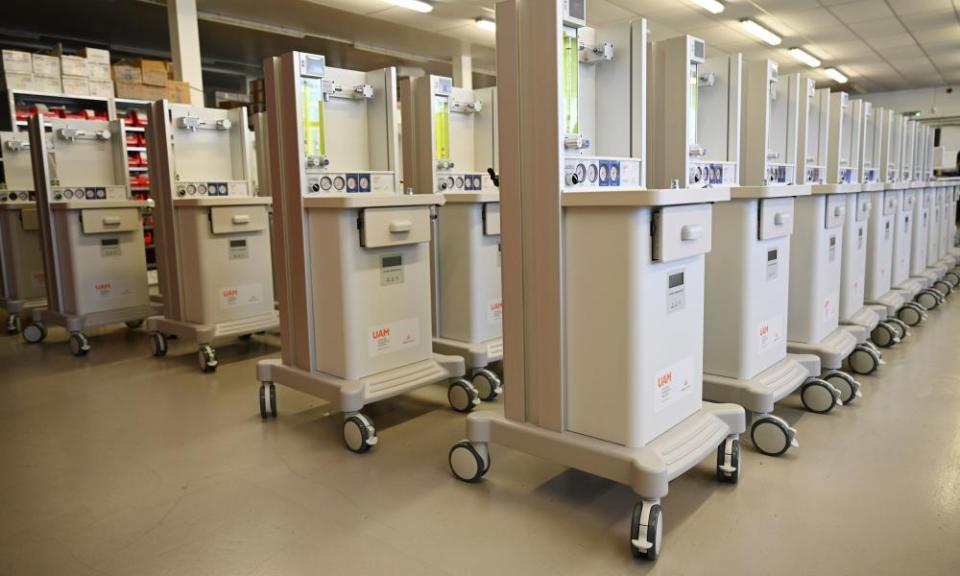NHS faces shortfall of ventilators as manufacturers struggle

Hospitals could be left without enough medical ventilators at the height of the UK coronavirus outbreak, with manufacturers struggling to build thousands of new machines in time for the likely mid-April peak in cases.
The NHS already has 8,175 ventilators but the government believes up to 30,000 could be needed and has enlisted manufacturers in a wartime-style effort to boost stocks to to at least 61,000. Officials are working on deals to increase that number and are expected to announce new orders for hundreds more machines in the coming days.
But the health secretary, Matt Hancock, said on Friday he could not dispute modelling suggesting that the peak for Covid-19 deaths could arrive on 12 April, Easter Sunday.
And sources involved in projects to import or build ventilators told the Guardian that ventilator production was highly unlikely to be in full swing before the end of the month, despite unprecedented collaboration within British industry.
One source familiar with one of the larger ventilator projects said that, despite the best efforts of high-end manufacturers, the target was “nowhere near” being met.
“You just can’t do this sort of stuff overnight, which is what they’re trying to do. But if there’s a second wave in the winter, we’ll have a lot more by then.”
Another admitted that it was impossible to “produce into the peak”.
“We should have started doing this weeks ago,” the source added.
Ventilator Challenge UK, a consortium of manufacturers including Airbus and Rolls-Royce, is helping scale up production of two types of ventilators made by specialist firms Smiths Medical and Penlon, with up to 15,000 ultimately promised to hospitals.
It expects to deliver new devices to the NHS early next week but only 30 are slated to arrive in the first batch and the consortiumsaid it would take weeks to reach maximum production levels due to the immense technical and logistical challenges involved.
“Ventilators are intricate and highly complex pieces of medical equipment and it is vital that we balance the twin imperatives of speed of delivery with the absolute adherence to regulatory standards that is needed to ensure patient safety,” said a spokesperson.
“To provide some context, Penlon and Smiths ordinarily have combined capacity for between 50 and 60 ventilators per week. However, thanks to the scale and resources of the wider consortium, we are targeting production of at least 1,500 units a week of the Penlon and Smiths models combined within a matter of weeks.”
The Guardian understands that the 1,500-per-week target is unlikely to be met by the end of the month, although the consortium is trying to bring peak production forward.
One factor adding to the uncertainty about how quickly ventilators can be delivered is that at least 35,000 of those ordered by the government still require approval from the Medicines and Healthcare products Regulatory Authority (MHRA) before they can be used to treat patients.
These include 5,000 models made by Penlon, and 10,000 each from engineer Dyson, defence firm Babcock and Cambridge-based tech firm Sagentia. The machines offered by the latter three firms have been designed from scratch and are yet to be used on patients.
Asked if there would be enough ventilators to meet peak demand, a government spokesperson stressed that there was no fixed date for the virus peak and that adherence to lockdown protocols would help reduce the number of cases.
“We are working night and day to ensure that we have ventilators to meet demand,” the spokesperson said. “The government is leading a coordinated effort to rapidly increase ventilator capacity and ensure these vital pieces of equipment are delivered to the frontline.”
On top of the 8,175 ventilators that the NHS has already, it has contracted a further 1,250 from private hospitals and expects 8,000 imports to arrive “in the coming weeks”, alongside several other new orders.
But the Department for Health and Social Care declined to release its forecast estimates for the number of ventilators required by the middle of April, or say whether it is braced for a shortfall.
An EU-wide ventilator procurement scheme, which the UK claims it accidentally failed to take part in, is due to begin soon, although it is unclear when the machines will be delivered.
British officials took part in four meetings where EU projects to bulk-buy medical kit were discussed – the earliest of them in January, according to official minutes.
Downing Street initially implied that the UK decided not to take part in the schemes deliberately and was “making our own efforts”, having left the EU. It has since claimed that Britain did not accept an invitation to join the process because officials accidentally missed the deadline, citing a “communication problem”.
The EU ventilator bidding round closed on 26 March and contracts are expected to be signed soon, with delivery dates yet to be finalised. The EU has separate procurement processes underway for masks, goggles and other protective kit for medical workers.
A European commission spokesman said the next step was signing the contracts. “The delivery times and the quantities of the ventilators will be negotiated by the member states and the suppliers.
“However, taking into account the difficult situation of the markets and the complexity of products, like for instance ventilators, their production and delivery is expected to take time.”

